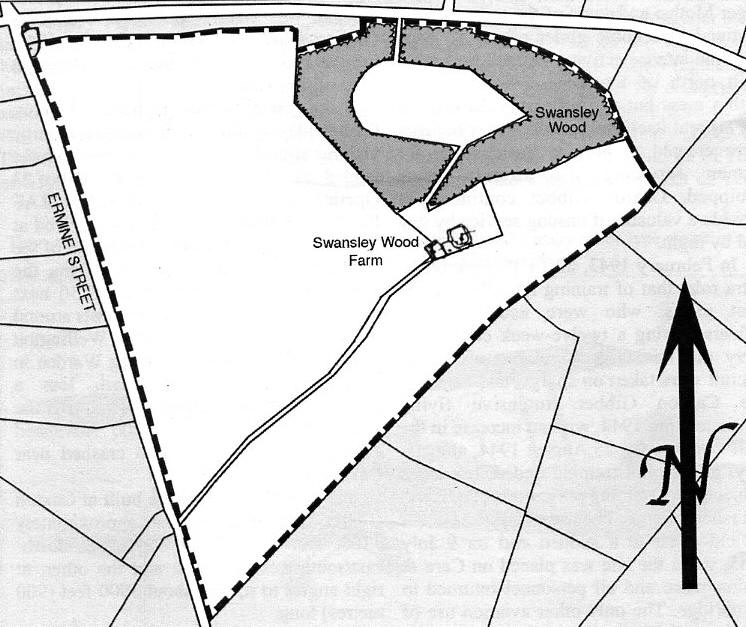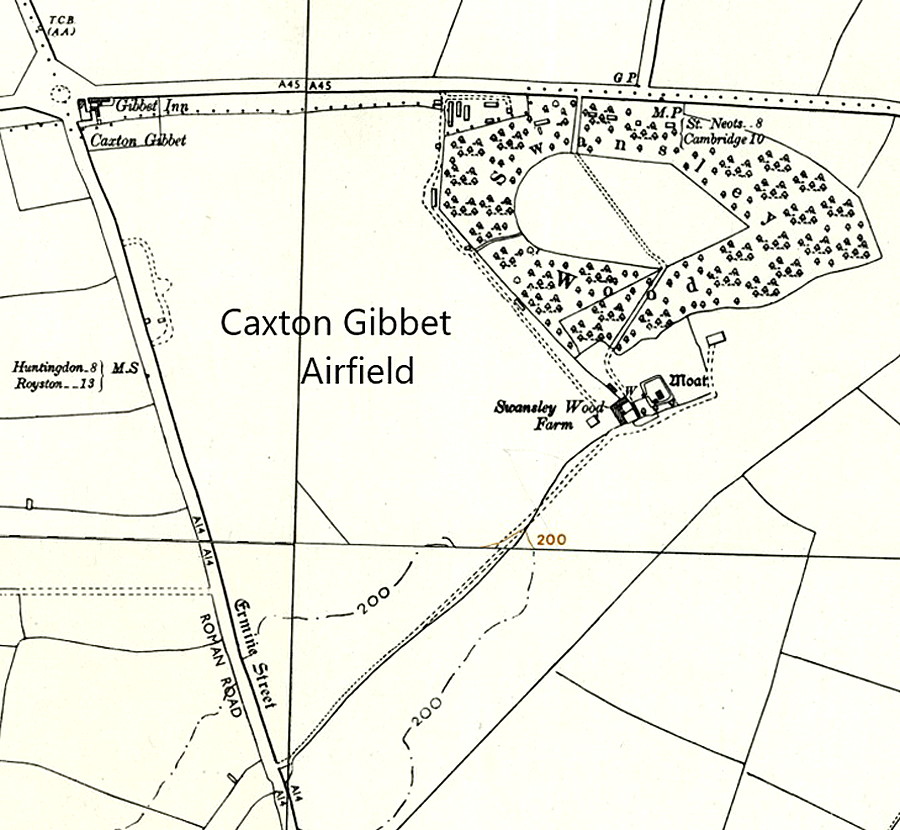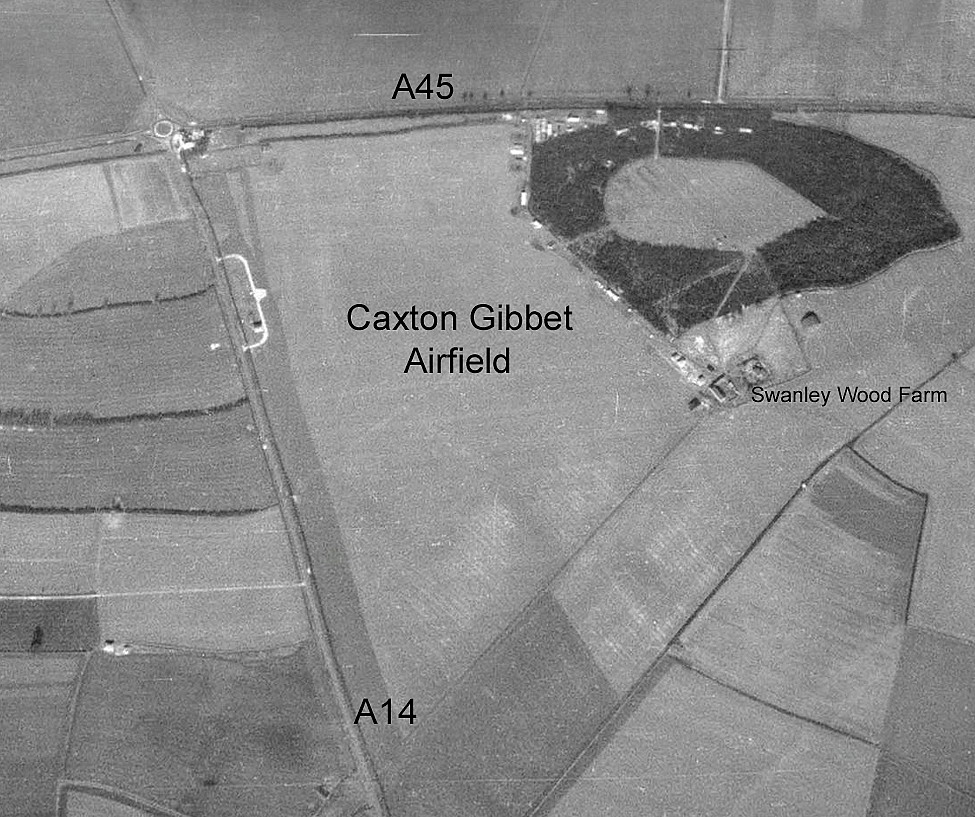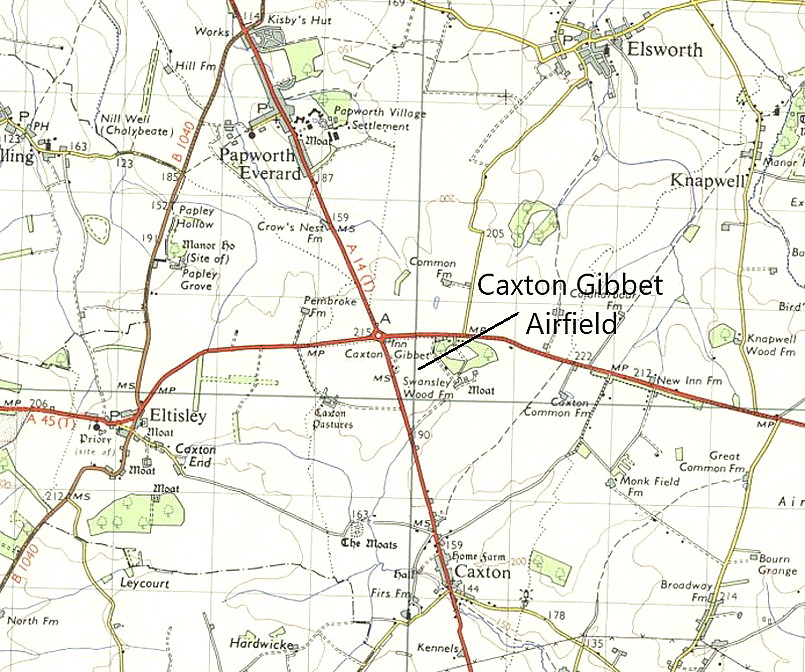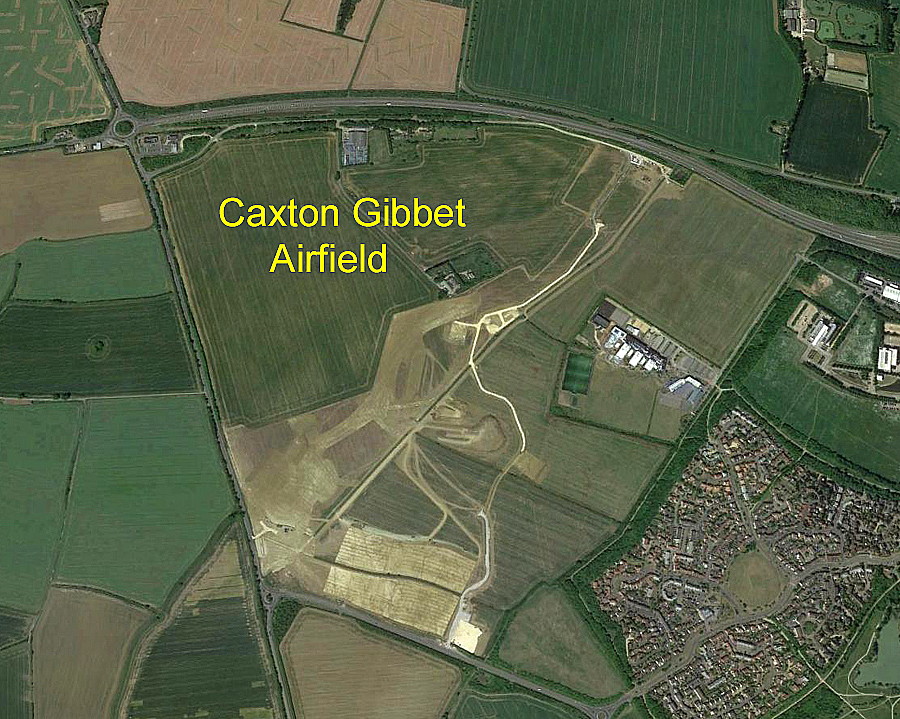Caxton Gibbet flying sites
Note: This map shows the location of the WW2 Relief Landing Ground
CAXTON GIBBET: Gliding site and airfield
Operated by: Cambridge University Gliding Club
Note: Map courtesy of GMS Enterprises
Location: Part of Swansley Wood Farm, imm. S of the A45 (now A428) and imm. E of the A14 (now A1198)
NOTES:
In 2016, whilst still working my way through the pile of books, maps and other sundry items I have collected over the years, I discovered to my delight, that at the back of Airfield Focus No.85 there is some information regarding the early years of CAXTON GIBBET, compiled by John F Hamlin.
To quote: "The airfield was first used by the gliders of Cambridge University Gliding Club, which had found the site in July 1934. It was not until 17 May 1935, however, before the first launch took place. Winched into the air by an old Morris car with a rear wheel jacked up to accommodate a drum on which the cable was wound, the gliders made good use of the site. The Club opened the airfield on 28 May 1938 as part of Empire Air Day and in July 1939 ran a camp for Air Defence Cadets."
"Powered aircraft belonging to Ely Aero Club, which was managed by Cambridgeshire Flying Services Ltd, began to use Caxton Gibbet as a relief landing ground about 1937. Using BAC Drone ultra-light aircraft and a Miles Cirrus Hawk, the Club began to train pilots recruited by the embryo Civil Air Guard, a subsidised programme intended to bring students to a certain standard in advance of impending hostilities. Although the Club had been busy at both Ely and Caxton Gibbet, it was not financially viable and was put up for sale in March 1939, but flying is thought to have continued for some time."
I made this note in around 2005: In 1937 a Mr Dimmock was operating the BAC Drone G-AEDB from CAXTON GIBBET. Incredibly this aircraft still exists and has been restored to flying condition at HUCKNALL in NOTTINGHAMSHIRE where it was expected to fly, once again, during 2007. Did this happen?
CAXTON GIBBET: Military aerodrome
Note: These four items were kindly provided by Mike Holder, a great friend of this 'Guide'.
Military user: RAF Flying Training Command 50 Group (RLG - Relief Landing Ground)
22 EFTS [Elementary Flying Training School] (DH.82 Tiger Moths)
Location: 9nm W of Cambridge
Period of operation: 1940 to 1945
Runways: N/E 1005 grass NE/SW 640 grass
E/W 548 grass NW/SE 914 grass
NOTES:
Following on from the information listed above when the airfield was civil, John Hamlin tells us: "The Air Ministry, which had listed Caxton Gibbet as a 'scatter' field for RAF Bassingbourn, took over the site in 1940 and expanded it by removing hedges and filling ditches, which created a fairly large L-shaped area for use as a relief landing ground by the Tiger Moths of 22 Elementary Flying Training School, based at Cambridge airport and managed by Marshall's."
EXTRAORDINARY NEWS
I was astonished to learn this from John Hamlin: "Enemy aircraft were soon active in the area, and on 15 July (My note; 1941) an intruder fired at Tiger Moths in the circuit and shot down two, R4962 and R4968, and at the same time attacked a gun-post." I have never heard of something like this happening - basic RAF training aircraft being attacked in the circuit at night!
What is really quite amazing is that I was kindly contacted by Julie Brown in January 2022 who had been typing up her husband's father's war diary. He is Ben Brown who eventually became a Squadron Leader and earnt a DFC.
"Along with all the others who has also gone solo, I started my next phase of flying from a little field near Caxton Gibbett. There I had a new instructor, Flt Lt Burnham. He was totally different in character, but we got on well, he was also an excellent instructor. Eventually, he sent me off on my first solo cross-country navigational exercise from Caxton Gibbett to Sywell. Little did he know but I already knew every inch of the way because the route was to take me right over home. It was to be a very easy exercise and I didn't get lost. En route to Sywell I did not shoot up home, faithfully abiding by the instruction given to me by Flt Sgt Sparrow and keeping the promise I made to him. As I flew past my farm, however, I did notice that they were haymaking and I was low enough to be able to recognise everyone in the field. (At the time I knew the name of every one of them)."
"On one occasion, I was flying with the Flt Lt. at about 5,000ft, when he suddenly closed the throttle to simulate an engine failure and told me to land. I selected a large grass field and glided down to land, much to my satisfaction. Once we were down, I was told to cut off the engine and that we should go looking for mushrooms. We didn't find any, so eventually we flew back to base."
"A few days later, my friend (the one who had excellent night vision) and I were ordered to do some night flying in the Tiger Moth. We both took off to do some circuits and landings but every time that I came into land, I was given a flashing red Aldis by air traffic control. This happened time and time again and I wondered what on earth could be wrong. I decided to go and circle a beacon station near St Neots. I returned to base a little later and this time was given a green light to land. When I taxied in, I was told that an intruder had been in the circuit and that he had shot my pal down. Luckily, he escaped without being too badly hurt."
One of the great aspects of producing a 'Guide' is that I am constantly contacted by a wide variety of people, many having an interesting tale to tell. However, what are the chances of this coincidence!
We'd love to hear from you, so please scroll down to leave a comment!
Leave a comment ...
Copyright (c) UK Airfield Guide















